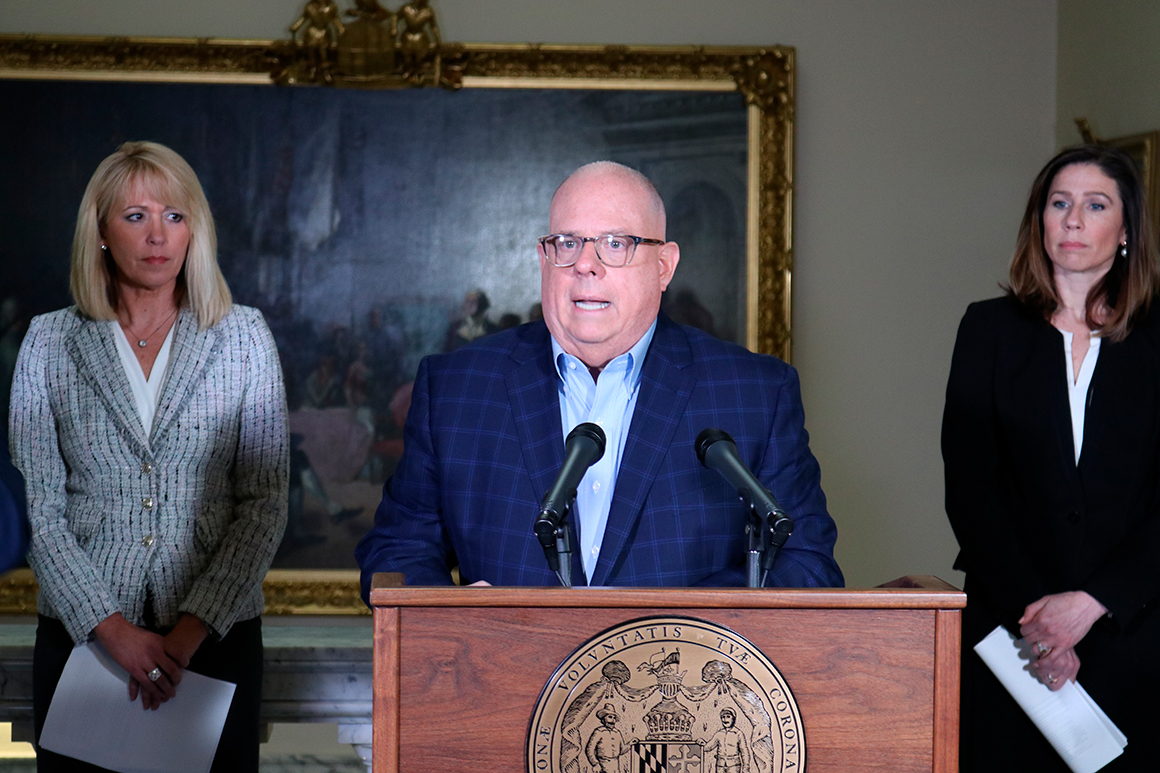
Hogan’s frustration burst into the open Tuesday, when he blasted Trump during a CNN interview for sending „pretty confusing“ messages on the virus that don’t sync up with the experience on the ground.
“Most people think we’re weeks away from the peak, if not months. That’s the advice we’re getting from the smart folks at Johns Hopkins, the National Institutes of Health, the University of Maryland, places like that,” Hogan said.
Ohio Gov. Mike DeWine on Wednesday said his state isn’t expected to experience peak infections until May 1. „The only way we slow it down is with physical/social distancing,“ he wrote on Twitter.
West Virginia Gov. Jim Justice, who presides over a state Trump won with more than 68 percent of the vote, on Monday ordered residents to stay home after the confirmation of the first case of community transmission, in a nursing home. Justice ordered the state’s National Guard to test everyone at the facility in a bid to control further transmission.
Such moves are more than a display of independence. Governors traditionally have the final say in public health crises and can declare emergencies to speed a response. New York Democratic Gov. Andrew Cuomo twice in the last decade temporarily suspended state laws and regulations to administer shots to children during season flu outbreaks. Pennsylvania Democrat Tom Wolf used similar powers to respond to the opioid crisis in his state in 2018.
In the case of coronavirus, Trump’s optimistic statements have been at odds with the assessments of top scientists and doctors, as well as administration officials such as Treasury Secretary Steven Mnuchin and Joint Chiefs Chairman Gen. Mark Milley, who’ve predicted a formidable battle that could last into the summer.
Officials from the World Health Organization warned Tuesday that the United States has the potential to become the epicenter of the global coronavirus pandemic based on the rapid uptick in confirmed cases.
Trump during a Tuesday evening appearance with members of his coronavirus task force suggested that social distancing may still apply to the hardest hit areas like New York state, which has reported over 30,000 cases as of Wednesday.
He said he will decide whether to extend nonbinding federal social distancing guidelines next Monday, 15 days after his administration first made the recommendations.
But Trump’s suggestions that the nationwide fight may already be winding down were at odds with efforts in some Republican-led states that seem to be just starting to ramp up their mitigation strategies, with more lockdowns and stay-at-home orders on the way.
Hogan this week ordered all nonessential businesses in Maryland closed, saying people weren’t taking social distancing guidelines seriously enough. Georgia Gov. Brian Kemp hasn’t gone as far as issuing a lockdown order, but on Monday announced the closure of bars and nightclubs and banned public gatherings of 10 or more people.
DeWine on Sunday issued a “shelter in place” order through April 6 for residents to stay in their homes for all but essential outings and closed nonessential businesses. Democratic-led states including California, Connecticut, Illinois, Louisiana, New Jersey and New York have similar orders under effect.
Texas Gov. Greg Abbott, meanwhile, during a Tuesday press conference, signaled he may be open to issuing a sweeping statewide stay-at- home order, after the largest counties announced their own lockdowns.
Abbott’s lieutenant governor and close Trump ally Dan Patrick created a firestorm Monday night when he suggested he’s had conversations with older constituents who said they would rather die than see the economy destroyed by the coronavirus lockdowns.
Florida Gov. Ron DeSantis, another Trump ally, has steered a more independent course, resisting political pressure to issue a shelter-in-place order but saying he would restrict visitors coming into his state from hot spots including New York.
Public health experts are most concerned that lifting national guidelines could undermine local, state and federal efforts to flatten the curve of disease spread at a time when they still don’t have a firm grip on who is sick and where.
“When you look at the country obviously no one is going to want to tone down things when you see what’s going on in a place like New York City. I mean, that’s just good public health practice and common sense,” NIH infectious disease expert Anthony Fauci said during the Tuesday press briefing, with Trump standing nearby. Fauci added that when testing ramps up more across the country, officials will get a better idea of whether they will need to continue federal guidelines for the whole country or if the focus will need to be in only certain, hardest hit areas.
Officials in some outlying areas with comparatively few cases appear content to take a wait-and-see approach. South Dakota Republican Gov. Kristi Noem on Tuesday said that, based on models, her state doesn’t expect to reach peak infection rate for at least another eight weeks. She hasn’t ordered a statewide lockdown but has restricted business and hospital operations.
“Whatever decisions we make … need to be sustained in the long term,” she said.
Source: politico.com
See more here: news365.stream






